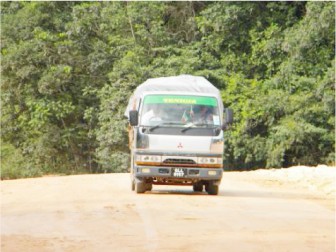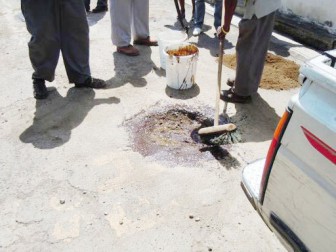Three years after a South African manufacturer first sought to introduce a soil stabiliser into road building and road rehabilitation in Guyana, the company is yet to receive a definitive response from either the public or private sector here.
Hazelene Bostwick, the Guyanese-born agent for the Johannesburg-based company Romix Industries, which manufactures the Polymer soil stabiliser SRB-5 that is used in road construction in Africa, Asia and in some Caribbean countries, told Stabroek Business earlier this week that rehabilitation tests conducted with the polymer on local roads point to the likelihood of long-term savings on road maintenance costs.

Given the amount of potholes and damaged roads in several parts of the country, there is evidence that sub-base failure has been one of our major problems. SRB deals with the sub-base problem, while ensuring that the surface is not easily compromised.
In 2009, Peter Prinsloo, the Romix General Manager, visited Guyana with a view to marketing the product here. Bostwick told Stabroek Business that apart from engaging both public and private sector officials, Romix imported more than 9,000 litres of their polymer into Guyana, some of which was used to conduct trials on two 100 metre stretches of road at Ituni.
The evidence of the efficiency of the product can be seen in the results, which are in the possession of the Ministry of Works.
Bostwick said that apart from discussions she has had with Works Minister Robeson Benn, other local entities, including the local authorities in Georgetown and Linden, had expressed an interest in using the substance in road-maintenance exercises. “As far as I recall there may well be around 2,200 litres of the polymer sitting on the premises of the Georgetown City Council. Another quantity, around 2,600 litres was bought by the Linden municipality. The material has not been used as far as I know,” she noted.

Bostwick also said representatives of the South African company had held discussions with various public and private sector officials about the application of the polymer on farm to market roads and on roads providing access to the forestry and mining communities. Asked about the government’s response to the company’s efforts to sell the polymer here, Bostwick would only say that while there was evidence of “some degree of interest,” the response had been “slow.”
Bostwick told Stabroek Business that trials conducted at Ituni as well as pothole filling done in parts of Georgetown suggest that “base and sub-base problems” have been among the main difficulties associated with Guyana’s roads. “That being the case SRB is ideal for local application since the substance migrates downwards and strengthens both the base and the sub-base of the roads,” she explained.
According to Bostwick, the Romix product has been used in various parts of Africa and has also been applied in road-building projects in China. “We are also working with some Caribbean countries where tests are to be done,” she added.
Bostwick told Stabroek Business that the polymer also offers the advantage of remaining unaffected by wet weather during application. “Another major cost-saving element has to do with the fact that it can be mixed with aggregate that has already been applied to the road which means that the old aggregate does not have to be discarded. We know the high cost of the aggregate used in the road construction industry here,” Bostwick told Stabroek Business.





